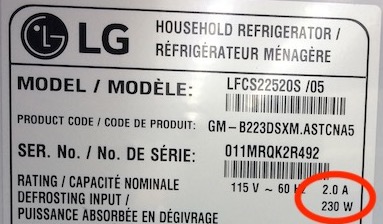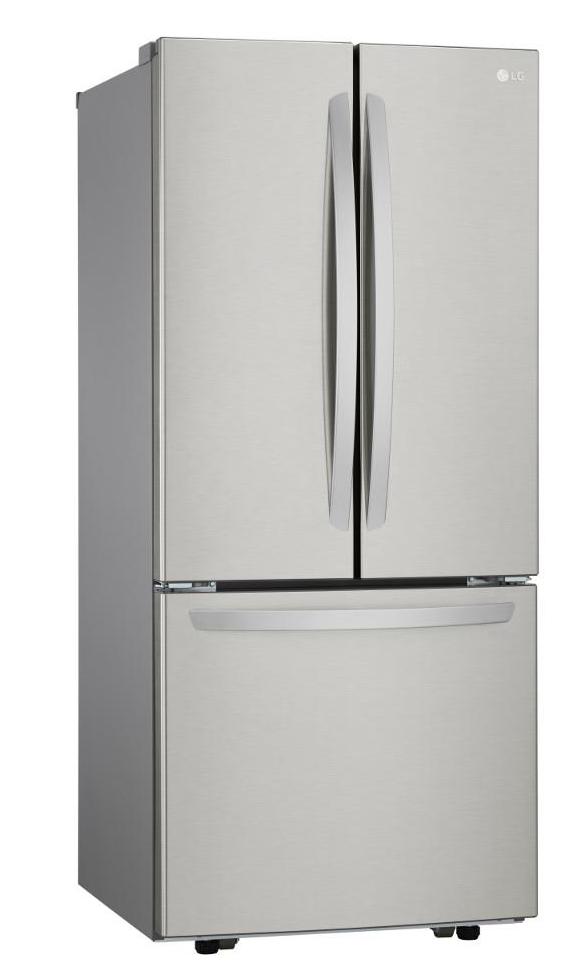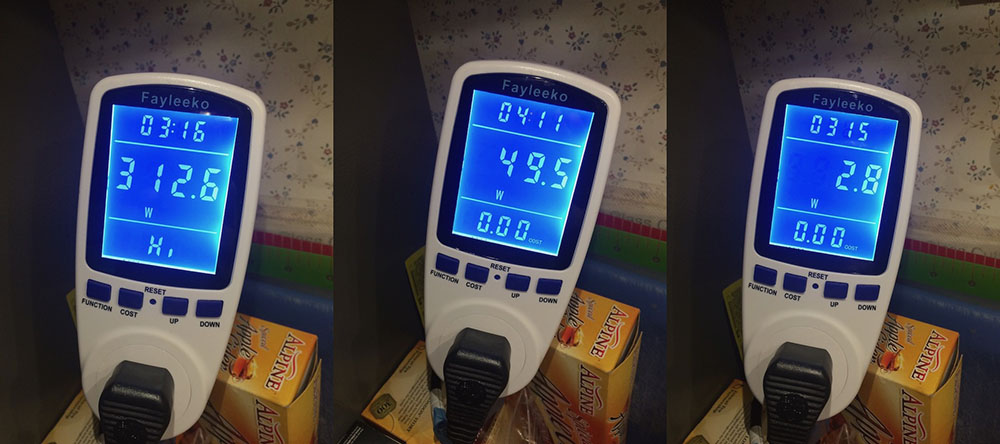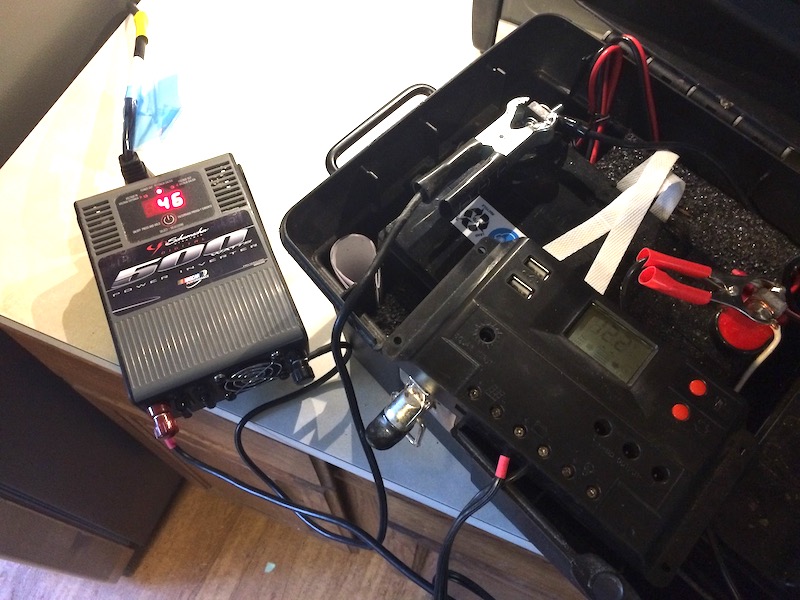
One of the big concerns during a power outage is that all the food in your fridge will spoil. To prevent that, preppers buy generators. Fridges used so much power that driving them from batteries was not practical…until now.
We bought a new fridge for lower power consumption (and for various non-prepper reasons, too). I was happily surprised that it was much lower in power consumption than its rating. So low, in fact, that I could run my new fridge off of my battery bank instead of my generator — a much nicer option for overnights and inclement weather.
This post may contain affiliate links.

Note the circle: 230 W
My old fridge drew 800 watts at regular running. It drew closer to 1,100 as a start up spike. My battery bank, with 35 AmpHours available (or 420 watt-hours) could run my old fridge for maybe a half an hour. Not too useful. My new fridge said it uses 230 watts. At face value, that’s almost a quarter of the usage — worth doing.
Power Hogs

My old fridge, like most conventional refrigerators, relied upon an AC motor to drive its compressor. AC motors run at a (more or less) constant speed and have power spike requirement to get them started. Since they run at a constant speed, they cool at a constant rate (full blast). When the thermostat tells the compressor to run, it does so at full speed (its only speed) until the thermostat says it’s cool enough. Then, the compressor shuts off. The fridge slowly warms back up until the cycle repeats.
This on-off cycle is akin to driving down the highway, gas pedal floored until you get up to 80 mph, then shutting off the engine and coasting until you get down to 40 mph before you turn the engine on again and floor it back up to 80, power-off and resume coasting. Lather, rinse, repeat.
As inefficient as AC compressor systems are, they were basically the only practical technology available in the 1930s and functional enough to be the standard for over 60 years.
My old fridge’s power appetite was the primary motivation for buying my generator years ago. I had wood for heat, and oil lamps for light, but I needed to keep my fridge/freezer food from spoiling. When we had power outages, I would rig up my generator to run the old Amana fridge for an hour or so until it had cooled back down. After that, it was a half-hour of running with an hour off in between. Workable, but my fridge-running time was obviously limited to how much fuel I had stored. It also required someone to be awake day and night to run the generator.
New And Improved!

About twenty years ago, fridge makers started introducing DC motors driven by inverters that can supply variable DC voltage from 120VAC house current. The DC motor can run at a low, steady speed when the cooling demands are low, drawing very little power. (No need to ‘floor it.’)
Even when demand is high — like when you have the doors open a lot — the DC motor can operate at max power more efficiently. It can ramp up to speed without a demand spike.
Real World Data
My new LG fridge had a rated power consumption of 230 watts. I used my watt meter (this one: from Amazon, but there are many comparable ones) to do some real-world testing. The results were a pleasant surprise.

When first plugged in, the fridge drew over 300 watts — a fair bit above the rating. That lasted for only a couple minutes before it ramped down to 270 watts. It ran at that load from about twenty minutes. After that, it settled into a normal load of around 50 watts for most of the time. It would occasionally spike up to 100 for a minute or two, but it would also go to sleep, basically, drawing only 2.8 watts.
Since the meter would keep a cumulative total, I collected data for four full days, or 96 hours. It drew a total of 4,644 watts over the 96 hours, giving an average consumption of just over 48 watts per hour. That is a power draw that my battery bank could handle.
Fridge By Battery
In theory, my battery bank should be able to run my fridge for eight straight hours. For the details about my battery bank, see my previous blog post. Basically, it has 420 Watt-hours of available power. Divide that by the average actual consumption of my new fridge (50 watts) and you get 8.4 hours. That’s sixteen times longer than the same battery running my old fridge (.5 hours). That’s the theory. What’s the reality?
Real World Testing
I unplugged my fridge from the wall and plugged it into my 500-watt inverter hooked up my fully-charged battery bank that measured 13.3 volts, and started the clock.
At first, the fridge was pulling over 270 watts. It ran at that load for twenty minutes. The voltage dropped rather suddenly from 13.3 to 11.9. I began to worry that my battery might not provide more than a half hour anyhow. But, after the twenty minutes, the load dropped to 18 watts. Battery voltage recovered to 12.5v.

Ups and Downs: Over the next several hours, the fridge settled into a steady pace of around 50 watts. There were a few spikes of 90-watt usage, but also some dips down to the teens and even 2.8-watts.
At the 7-hour mark, I had to end my experiment as I had to get to church. My batteries were registering 11.9 volts on my solar panel controller. My inverter said the batteries were providing 12.1 volts. My multimeter read: 12.2 volts. The reality was probably in the middle: maybe 12.1. After the fridge’s power consumption settled down, the batteries were dropping at approximately 0.083 volts per hour.
Half-Power Limit: The rule of thumb for deep cycle batteries is to drain them down to no more than half power before charging them up again. Half power isn’t easy to quantify. My charge controller thinks 11.6 is half power. My personal dotted line is 11.9 volts. If I took the inverter’s reading (12.1) to be closer to reality, I still had 0.2 volts to spend — over an hour of battery left. This real-world test showed that I could, indeed, run my new fridge off my battery bank for about 8 straight hours. This isn’t enough to be completely off-grid, of course. My batteries only did one-third of a day. What this test did prove, is that I could run my fridge for many hours without having to set up my generator.
Advantages
• If we lost power on a dark and stormy night, I could run the fridge off of the batteries for a less dark and stormy time to set up the generator.
• I could charge my batteries with a generator run of a couple hours instead of a half hour on, an hour off, etc. Less actual generator runtime.
• I could run the fridge off of one of the vehicles’ batteries for a while as an alternate.
• I can extend battery runtime during daylight, using the solar panels. Even on a gray day, I was able to add .1 volts in a couple hours rather than lose any volts per hour.
• I could sleep for a few hours while the battery ran the fridge. No staying awake to monitor a running generator. No noise to attract attention, either.
• With increased capacity, I could (in theory) run my fridge round the clock from batteries, giving me more off-grid food preservation options.
Next Project
To improve that off-grid capacity, my next project is a second battery bank so one can be recharging while the other is running the fridge, etc. To improve recharge times, I’m adding a couple more solar panels. Ah, but that’s a story for another day.
What About YOUR Fridge?
If your fridge is over twenty years old, it is probably the old-style AC motor-compressor type. Check the label (around the door frame someplace, or on the back) to see how many watts or amps it’s rated at. My old one said 800 watts or 6 amps.

Even the new, less expensive fridges ($500 range at Home Depot) appear to be using inverter technology, although it isn’t always made clear. The government-mandated energy labels won’t tell you the amps or watts. Instead, they tell you kilowatt-hours per year. They make you do the math. For example, this one says 387 kWh per year: that’s 387,000 watts per year. Divide that by 8,760 (24 hrs x 365 days) and you get 44 watts per hour — do-able with an adequate battery bank.
While you can buy smallish refrigerators built to run directly off 12 volts (like for RVs), nowadays, you’re not limited to RV fridges to be off-grid. The new inverter technology fridges can be run off batteries too.

Excellent report Mic! Now for the daring you could see if you can find the wiring diagram and specs for that fridge. That way you *might* depending on the DC voltage required eliminate the power used by the AC to DC “inverter” (actually I think it’s a rectifier) and thus reduce the power losses. The old rule of thumb is a loss of 10% per change. Example 100 watts from the panel into the battery is 90 watts, from the battery to the inverter around 81 watts, from the inverter to the Rectifier for that fridge well…
More modern equipment can be better in this exchanges but I prefer to have too much power than just not quite enough.
Hi Michael,
Yeah, I’m reluctant to disassembling a new fridge that’s still under warranty. My hunch is that the inverter isn’t going to be a stand-alone box that can be bypassed. The way the literature describes the variable power sent to the motor, depending on what the sensors say, leads me to think it’s more integrated.
Yes, there are undoubtedly some losses going from DC to AC and then back to DC. Pure DC appliances would help. It’s a pity there isn’t a bigger market (and thus a better selection) of those.
appreciate the article – great info, thanks
I am sharing with a friend who has 2 freezers and wants backup power to run them